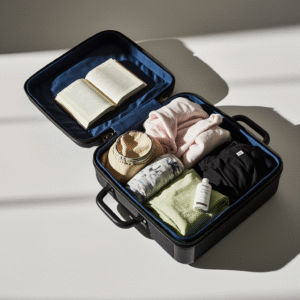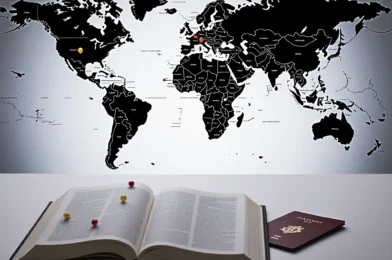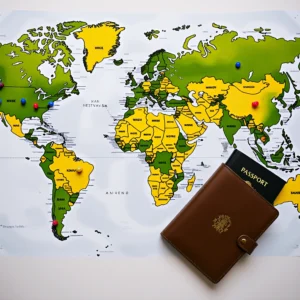You feel the call. It’s a stirring in your spirit, a desire to step beyond your comfort zone and make a tangible difference in the world. A mission trip can be one of the most transformative experiences of your life, both for you and the communities you serve. But between the initial spark of an idea and the moment your feet touch the ground in a new country lies a mountain of planning. It can feel overwhelming, even impossible.
Where do you even begin?
Don’t worry. You’re in the right place. This is your comprehensive, step-by-step guide to navigating the entire process. We will break down the journey into manageable phases, from defining your purpose to processing your return home. Think of this as your mission trip planning checklist, designed to give you clarity and confidence. By taking a thoughtful, deliberate approach, you can ensure your trip is impactful, responsible, and life-changing for everyone involved.
Let’s get started.

Phase 1: The Foundation (12-18 Months Before Departure)
The longest and most crucial phase happens long before you pack a bag. Laying a strong foundation is the single most important factor in the success of your trip.
Step 1: Define Your “Why” — The Purpose and Vision
Before you look at maps or research flights, you need to look inward. Why are you going on this trip? This question must be the bedrock of every decision you make. A clear purpose will guide you when logistics get complicated and will unite your team around a common goal.
- Pray and Discern: Spend serious time in prayer and reflection. What is God calling you or your group to do? Is the focus on evangelism, construction, medical aid, education, or relational ministry?
- Establish Core Goals: Be specific. Instead of “we want to help,” define what that means. Is it to build one house for a specific family? Is it to run a week-long vacation Bible school for 100 children? Is it to provide 200 dental check-ups? Clear, measurable goals will help you plan effectively and measure your impact later.
- Write a Mission Statement: Craft a one or two-sentence mission statement for your trip. For example: “Our mission is to partner with the local church in rural Guatemala to build a clean water system and foster relationships that share the love of Christ.” This statement will be your guiding star.
Step 2: Assemble Your Core Leadership Team
You cannot and should not plan a mission trip alone. You need a small, dedicated team of leaders to share the workload and provide accountability.
- Key Roles: Your leadership team might include a main trip leader, a logistics coordinator (handling flights and transport), a finance manager (overseeing the budget and fundraising), and a spiritual director (leading devotionals and team preparation).
- Look for Faithfulness and Skill: Choose people who are not only passionate about the mission but also reliable and skilled in their respective areas. A well-organized leader is just as valuable as a charismatic one.
Step 3: Choose Your Destination & Partner Organization
This is a monumental decision. Where you go and who you work with will define your entire experience. Resist the temptation to simply pick a location that looks interesting. Instead, focus on partnership.
- The Importance of Partnership: The most effective mission trips work with and under the direction of local, on-the-ground leaders and organizations. They know the community, the culture, and the real needs. Your role is to come alongside them as a supporter, not a savior.
- Vetting an Organization: When researching a mission-sending agency or a local partner, ask critical questions:
- Do they have a long-term presence in the community?
- Is their work led by local people?
- How do they ensure the work continues after your team leaves?
- What are their safety and security protocols?
- Can you speak with past team leaders who have worked with them?
- Avoid “Voluntourism”: Be wary of any organization that seems to prioritize the experience of the volunteer over the needs of the community. A responsible mission trip is about service and empowerment, not about a feel-good vacation with a service project tacked on.
Step 4: Create a Preliminary Budget and Master Timeline
With a destination and potential partner in mind, you can start to crunch the numbers. This initial budget will be an estimate, but it’s essential for recruiting and fundraising.
- Estimate Per-Person Cost: Your partner organization can usually provide a good estimate. Factor in:
- Airfare
- In-country costs (food, lodging, transport) provided by the host
- Project funds/donations
- Team insurance (medical and evacuation)
- Administrative fees
- A contingency fund (always add 10-15% for unexpected costs)
- Draft a Master Timeline: Work backward from your desired departure date. Mark key deadlines for applications, deposits, flight bookings, training sessions, and fundraising milestones. This church mission trip planning tool will keep everyone on track.
Phase 2: Building Momentum (6-12 Months Out)
Now that your foundation is set, it’s time to build your team and the financial resources to make it happen.
Step 5: Recruit Your Team
It’s time to share the vision! Announce the trip to your church or community. Your goal isn’t just to fill spots; it’s to assemble a team with servant hearts and flexible attitudes.
- Application and Interview Process: Require a formal application. This helps individuals seriously consider their commitment. The application should ask about their faith journey, relevant skills, and why they want to join the trip. Follow up with a short, informal interview to get to know them and clarify expectations.
- Team Covenants: Create a “team covenant” or agreement that outlines expectations for behavior, attitude, fundraising, and participation in pre-trip meetings. This prevents misunderstandings down the road.
Step 6: Launch Your Fundraising Campaign
The cost of a mission trip can be a major barrier for many. A proactive and creative fundraising plan is essential. Your strategy should include both individual and group efforts.
- Individual Support Raising: The most common method is for each team member to write support letters to friends, family, and their personal network. This is more than just asking for money; it’s inviting others to be part of the mission through prayer and financial partnership. Coach your team on how to write compelling letters that share the “why” of the trip.
- Group Fundraising Ideas:
- Benefit Dinners or Dessert Nights: Host an event where you share the vision for the trip and invite donations.
- Online Giving Campaigns: Utilize platforms like GoFundMe or church-specific giving software to make it easy for people to donate online.
- Service Auctions: Team members auction off services like babysitting, yard work, or baking.
- Restaurant Partnerships: Many local restaurants will donate a percentage of their sales on a specific night to your cause.
Step 7: Hold Your First Team Meetings
Once your team is formed, start meeting regularly. These initial meetings are less about logistics and more about building unity and a shared vision.
- Agenda Items: Use this time for team-building activities, praying for the mission and each other, casting the vision (reiterate the “why”), and introducing the culture you will be visiting. This is the start of your team’s spiritual preparation.
Phase 3: The Detailed Logistics (3-6 Months Out)
The details are coming into focus. This phase is all about locking in the critical travel components.
Step 8: Handle the Paperwork — Passports, Visas, and Insurance
This is a non-negotiable, detail-oriented step. One mistake here can derail a team member’s ability to travel.
- Passports: Instruct every team member to check their passport immediately. Ensure it is valid for at least six months after your planned return date. This is a requirement for many countries. If anyone needs a new passport, they must apply now.
- Visas: Work with your partner organization to determine if visas are required for your destination. The visa application process can be lengthy, so start early.
- Insurance: Do not travel without comprehensive team insurance. This should cover medical emergencies, trip cancellations, and, most importantly, emergency medical evacuation. Your sending organization will likely require this and can recommend a provider.
Step 9: Book Flights and Arrange In-Country Transportation
With passport details in hand, you can book your airfare. This is often the largest single expense in your budget.
- Group Travel Agents: For teams larger than 10, consider using a travel agent specializing in group or humanitarian airfare. They can often find better rates and more flexible terms than public websites.
- Confirm In-Country Logistics: Re-confirm all in-country transportation plans with your host organization. How will you get from the airport to your lodging? How will you travel to the work site each day? Don’t leave these details to chance.
Step 10: Plan Your Itinerary in Detail
Work with your host partner to create a daily schedule. A well-planned itinerary prevents wasted time and manages team energy levels.
- Balance Work and Rest: A typical day might include breakfast, a morning devotional, travel to the work site, work on the project, lunch, more work, and then returning for dinner.
- Schedule Team Time: Intentionally schedule time for daily team debriefs. This is a space to share what you’re learning, process challenges, and pray together.
- Cultural Experiences: Plan at least one day or afternoon for a cultural experience, like visiting a local market or historical site. This honors the host culture and enriches your team’s understanding.
Phase 4: Final Preparations (1-3 Months Out)
The trip is just around the corner! This phase is about preparing your team’s hearts, minds, and bodies for the journey ahead.
Step 11: Focus on Spiritual and Cultural Training
This is perhaps the most overlooked yet critical part of preparation. How you enter the community is just as important as the work you do.
- Cultural Sensitivity Training: Your goal is to be a learner, not a teacher. Research the culture you are entering. Learn about social norms, appropriate dress, gift-giving etiquette, and communication styles.
- Learn Basic Phrases: Learning simple greetings and phrases in the local language (like “Hello,” “Thank you,” “My name is…”) shows respect and helps break down barriers.
- Spiritual Readiness: Ramp up your team’s spiritual preparation. Hold a dedicated prayer night for the trip. Study scripture related to missions, service, and humility. Prepare your hearts to see God at work in unexpected ways.
Step 12: Finalize Packing Lists and Medical Prep
- Provide a Detailed Packing List: Give your team a specific list of what to bring and what to leave at home. Differentiate between personal items and team supplies (e.g., project materials, first aid). Emphasize modest dress that respects local customs.
- Medical Consultations: Advise every team member to consult their doctor or a travel clinic. They need to get any required vaccinations and obtain necessary personal medications for the duration of the trip.
- Team First-Aid Kit: Designate one person to assemble a comprehensive team first-aid kit with supplies for common ailments like stomach issues, cuts, and dehydration.
Step 13: Establish Communication and Safety Protocols
Before you leave, everyone should know the plan for communication and emergencies.
- Communication Plan: How will the team communicate with family back home? Set clear expectations (e.g., “The team leader will send a group email every two days”). Will there be Wi-Fi? Cell service?
- Emergency Plan: Have a documented plan that includes:
- Contact information for your partner organization, the local embassy, and your insurance provider.
- A designated emergency contact for each team member.
- A clear chain of command for decision-making in a crisis.
Phase 5: On the Ground & Post-Trip (The Journey and Beyond)
You’ve planned, you’ve prepared, and now you’re finally there. But the journey doesn’t end when you get back home.
Step 14: Execute the Mission — Be Flexible
You have a plan, but remember that you are a guest. Things will change. The schedule might be delayed. A project might shift. Your most important skill on the field is flexibility.
- Embrace Servant Leadership: Your posture should be one of humility. Ask “How can we help?” rather than stating “Here’s what we’re here to do.” Defer to your local hosts.
- Focus on People, Not Projects: The relationships you build are more lasting than any building you construct. Take time to listen to people’s stories. Play with the children. Share meals. Be present.
Step 15: Prioritize Post-Trip Debriefing and Re-entry
Returning home can be surprisingly difficult. Reverse culture shock is real. Processing the experience as a team is vital for healthy re-entry.
- Immediate Debrief: Before you leave the country or immediately upon return, hold a final team debriefing session. What did you see? What did you feel? How did you see God move?
- Plan a Follow-Up Meeting: Schedule a reunion a few weeks after you return. This allows everyone to process how they are re-adjusting to life at home. It’s a space to share stories and encourage one another.
Step 16: Follow Up and Continue the Relationship
Your responsibility doesn’t end when the trip is over.
- Thank Your Supporters: Send a follow-up report and thank you notes to every single person who prayed for or donated to your trip. Share pictures and stories of how their partnership made a difference.
- Report Back: Prepare a presentation for your church or community. Share what you accomplished, what you learned, and how they can continue to support the work of your partner organization.
- Stay Connected: The best mission trips are the beginning of a long-term relationship. Find ways to stay in touch with your host partners and continue to support them through prayer and finances long after you’ve returned home.
Planning a mission trip is a profound act of faith and a significant undertaking. It requires diligence, prayer, and a deep commitment to serving others well. By following these steps, you are not just organizing a trip; you are creating a framework for a powerful, responsible, and truly transformative experience. You are building a bridge between communities and paving the way for God to work in incredible ways—both in the lives of those you serve and in your own heart.
Now it’s your turn. What’s the biggest challenge you’re facing in your mission trip planning? Share your questions or your own tips in the comments below! Let’s build a community of support right here.
 Why Packing Right Matters
Why Packing Right Matters



